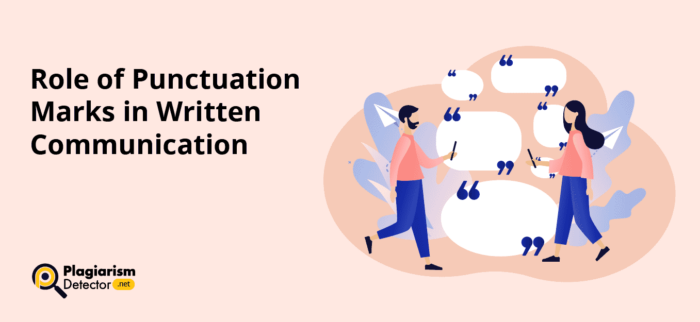Role of Punctuation Marks in Written Communication

Communication is an essential component of a human’s life. Without it, people can’t convey their intended message to the target audience. Writing is one of the most challenging forms of communication to master. This type involves adhering to a heap of predefined rules to communicate the desired message. One of such guidelines is the proper use of punctuation marks.
Punctuation signs are as vital in written communication as the air we breathe. Besides serving as a silent force in textual communication, punctuation signals influence the fundamental core of our language.
First, We’ll review the significance of punctuation marks in textual communication here. Following that, we’ll explain the purpose of a few common punctuation signs and provide examples. So, let’s get going without further ado.
Why Are Punctuation Marks Essential in Written Communication?
Punctuation symbols help readers understand how to interpret sentences when to stop, and the general tone of the text. So, it won’t be wrong to claim that they act as a guidebook to interpreting textual communication. Here are a few points that highlight why punctuation marks are essential:
Enhance the Clarity of a Write-Up
Clarity is one of the most essential qualities of textual communication. It will be useless if a text can’t convey its intended message. This is where punctuation marks come in useful. The proper placement of punctuation ensures that the message is clear and understandable.
Serve as Guidance and Make the Content Understandable
Humans naturally prefer to understand a message better when they see the one delivering it. Therefore, one of the factors contributing to the difficulty of written communication is that readers need help seeing the person conveying the message.
This often makes it challenging for the audience to determine whether a writer utilizes a severe or humorous tone. To solve this issue, experts introduced the concept of punctuation. And with their appropriate placements, it becomes easier for people to grasp the writer’s intended tone quickly.
Elevate the Readability and Aesthetic Appeal of Text
Readability, like clarity, is another crucial feature that contributes to the success of a content piece. An unorganized text is more challenging to read than an orderly one. So, to retain the text’s visual appeal and engagement, writers prefer to use various punctuation. This allows the material to flow more easily and improves the overall experience for readers.
Reflect Well on Writer’s Professionalism and Credibility
Ever since the advent of AI-powered content generators, many have begun to believe that anybody can become a writer. This has shifted the dynamics of the writing industry. As a result, people nowadays favor writers with higher trustworthiness. That’s where punctuation can be helpful.
By carefully inserting punctuation marks, writers can link ideas, stress specific points, and better guide readers through their thoughts. The continued adoption of this practice ultimately assists writers in gaining tremendous respect their community.
Role of the Common Punctuation Marks Used in Written Communication
You may now have a general knowledge of punctuation’s role in written communication. So, let’s talk about the functions of common punctuation marks and provide some examples.
Apostrophe
When writers want to form contractions or signify possession in their content, they use the apostrophe (‘) symbol with specific nouns or pronouns. The sentence below is a prime example of this punctuation sign:
Zorro’s toy was lying in the corner of the room.
Comma
The most frequent punctuation symbol is a comma (,). This punctuation mark helps highlight non-essential information, like adjectives, adverbs, and specific phrases, and for dividing two separate clauses. Here is an example of each use case of comma:
The cake was fluffy, moist, and tasty.
My brothers enjoy vanilla ice cream, but I like chocolates more.
You can also use an online comma checker to check for misplaced commas, so they can be placed correctly.
Exclamation Mark
When writers wish to portray strong emotions, like enthusiasm, surprise, or urgency, they use the exclamation mark (!). This punctuation mark is also helpful in highlighting a particular idea in a write-up. Here is a statement that shows the appropriate use of the exclamation punctuation mark:
I can’t believe it! We won!
Beware! What Are Top 10 Punctuation Marks in English Grammar?
Full Stop
The full stop (also known as a period) shows the completion of a declarative phrase. So, writers often use this symbol to indicate the ending of a communicated idea or thought in a sentence. The following sentence represents an example of this punctuation sign:
Stopping symbols act as subtle storytellers in textual communication.
Question Mark
As the name indicates, the question mark (?) symbol is suitable for signifying a question or the end of an interrogative sentence. Writers often use this punctuation mark to encourage conversation or engagement among the readers. Here is a sample that illustrates the perfect usage of this punctuation symbol:
Are you enjoying your vacation?
How Can One Ensure the Correct Placement of Punctuation Marks?
So far, you have learned the importance of punctuation and when to utilize the most common punctuation marks in written communication. However, we understand how difficult it can be to recall the rules of punctuation marks. And since punctuation can’t be overlooked, one must learn how to utilize it correctly to create a high-quality writing piece. This is where our punctuation checker will come in handy.
Pro Tip: Written communication involves more than just the proper placement of punctuation. It also requires the correct implementation of grammatical principles. But if you are unfamiliar with those norms, use our AI-powered grammar checker. Like our punctuation checker, our grammar corrector works by understanding the intent and meaning of the input.




